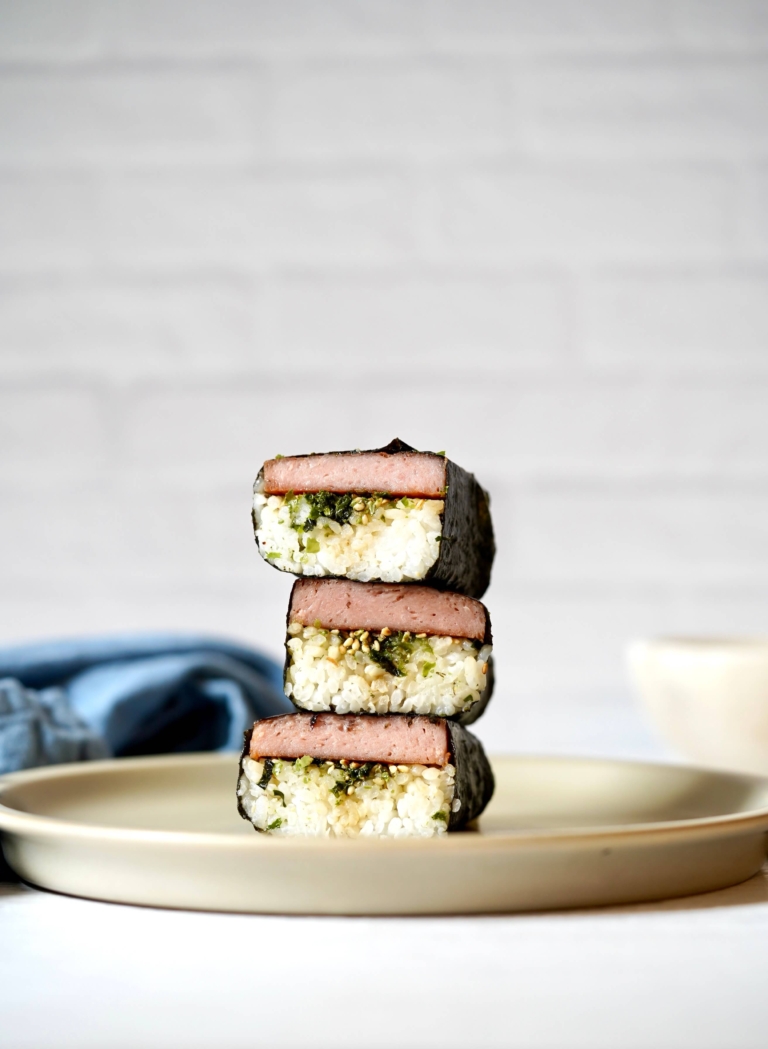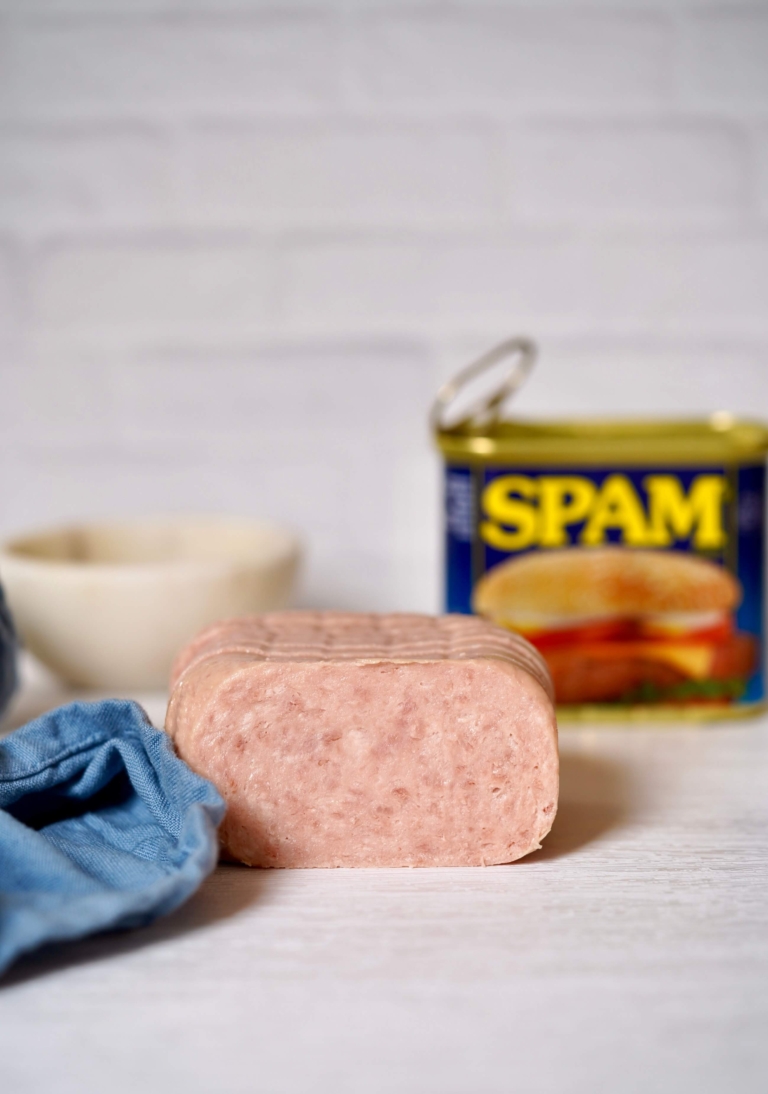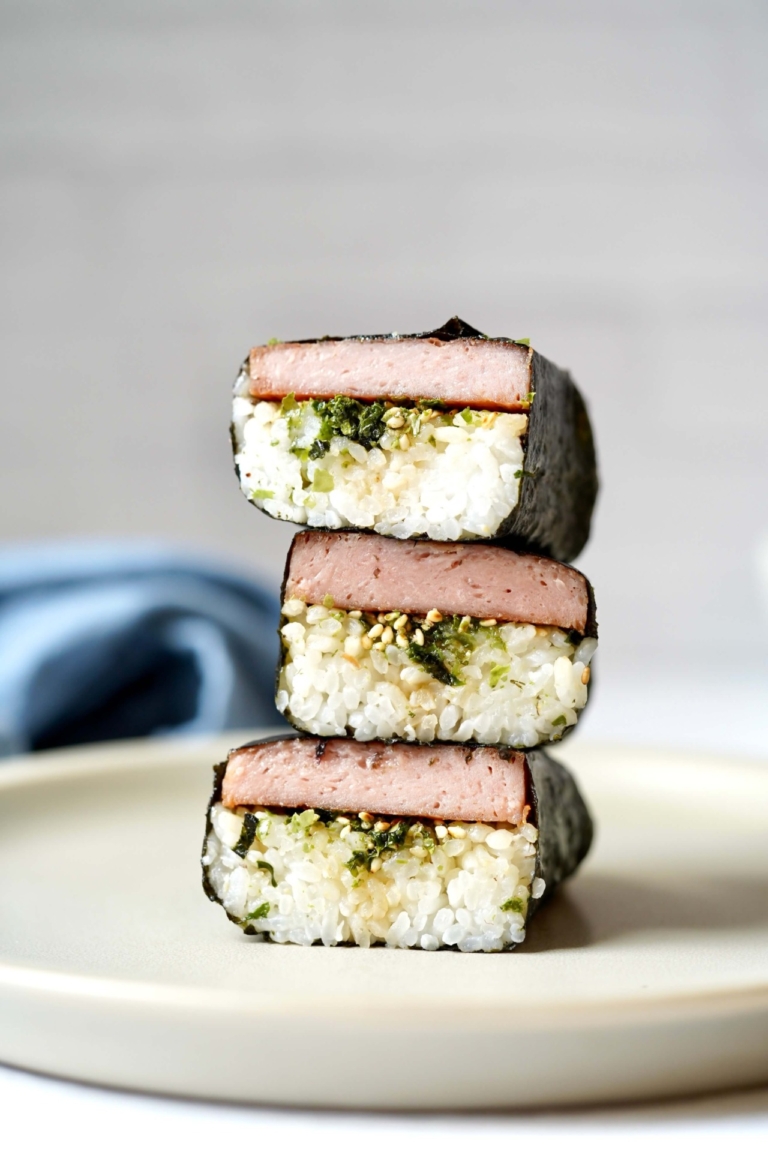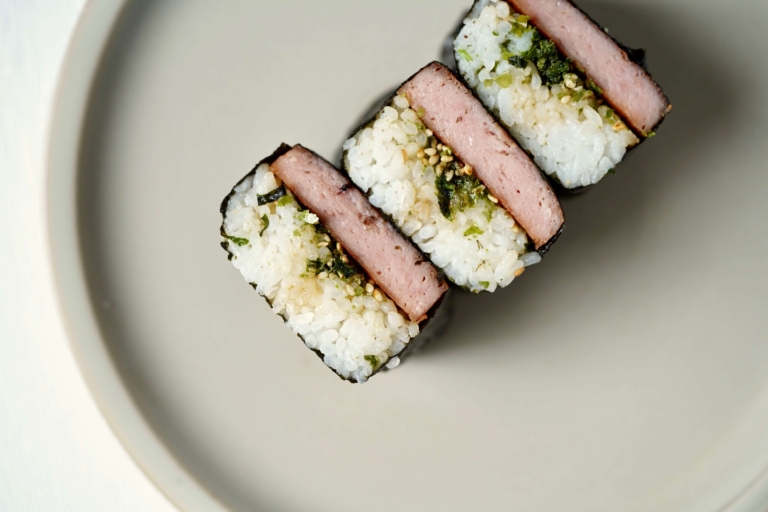Spam Musubi

For all the many times I’ve been to Hawaii, I never had Spam musubi there. Not sure how that’s possible, yet here we are. This was a request from my older son and now I’m hooked. Spam musubi is delish, but yes, you must get past the Spam part to fully embrace it and its incredible layering of flavors. Pan-fired, teriyaki glazed Spam, wrapped in nori seaweed with white rice and furikake, creating the perfect sweet-savory handheld treat. Spam musubi is a timeless Hawaiian tradition and a satisfying comfort food for those who have been raised with it.
The Backstory of Spam Musubi
Musubi in its simple terms is a Japanese rice ball. Also known as “onigiri” or “omusubi”, this classic comfort food is popular in Japan due to its portability. Spam musubi is Hawaii’s take on this well-known Japanese food made with local ingredients.
Barbara Funamaura, a Japanese-American woman living in Hawaii, is credited with inventing Spam musubi around the 1940s. Her creation took the beloved Japanese rice ball and used Spam (a popular ingredient in Hawaii at the time) as the musubi filling. Spam musubi quickly became a favorite dish among locals and one that reflects the unique blend of cultures on the Hawaiian islands. Spam musubi is considered an iconic part of Hawaiian food culture enjoyed by locals (and tourists) any time of any day.
Not Sushi
Many people will describe Spam musubi as “Spam sushi” or “sushi made with Spam”, but that is false. While musubi may share some basic characteristics with sushi, it’s a completely different food and deserving of that recognition. Perhaps the biggest difference many don’t realize is that Spam musubi uses plain steamed rice rather than sushi rice which is made with rice seasoned with vinegar, salt, & sugar.
Spam
If you’ve spent time in Hawaii you will already know that Spam is a celebrated ingredient on all the islands. It is a popular add-on for many local Hawaiian dishes, and so popular that one can grab a Spam musubi at local airports or even order Spam & eggs on the breakfast menu at McDonald’s.
Created by Hormel Foods in 1937, Spam was sold around the world as a convenient, protein-packed food for soldiers in World War II. Spam first arrived in Hawaii with the American military after the bombing of Pearl Harbor. Locals quickly became enamored of the rich, salty flavor & unbeatable convenience. Spam has been an iconic ingredient in the local Hawaiian food scene ever since.
Tips + Tricks to Making Spam Musubi
- Spam to Rice Ration: The spam should not be too thick or too thin.
- Best Rice To Use: Either short-grain or medium-grain white rice is best for making spam musubi. Musubi rice needs to have a light yet slightly sticky texture. Handle the rice carefully and do not flatten it.
- Musubi Molds: Molds can be helpful but not required. Truthfully, I use a sushi roller and although a bit trickier, can work just as well.
Spam
The lore behind the name Spam varies if you read about it. Hormel claimed the all-pork product was named for a combination of the words “spice” and “ham,”. The confusion has led some to speculate that Spam is an acronym for “Shoulder of Pork and Ham”. But the company gives Kenneth Daigneau, the brother of a Hormel VP, credit for naming the product.
My uncle, and his kids who relocated to Maui, embraced Spam musubi early on. Whether you love Spam it, love to hate it, or you’ve never tried it, now’s the time to give this quintessential Hawaiian classic comfort food, a try, it’s delightful and my son agrees.
Spam Musubi
Ingredients:
For the Musubi:
- 2 cups short or medium grain rice, rinsed well
- Nonstick cooking spray
- One (12-ounce) can Spam, sliced lengthwise into 7 pieces
- 3 1/2 sheets sushi nori
- 1/3 cup furikake
For the Teriyaki Sauce:
- 1/3 cup brown sugar
- 3 Tablespoons soy sauce
- 2 Tablespoons mirin
- 1 1/2 teaspoons sesame oil
- 1 nori masubi mold not required, but easier with one
Directions:
- For the Rice: Place the rice in a fine mesh colander and rinse it very well with cold water until the water runs clear. Once the water runs clear, drain any excess water from the rice, and transfer it to a saucepan. Cook per the package directions. Allow the cooked rice to rest for 5-10 minutes before assembling the Spam musubi.
- For the Teriyaki Sauce: While the rice is cooking, prepare the sauce. Place all the sauce ingredients in a small bowl, whisking to combine. Microwave for 30 seconds or so to dissolve the sugar. Stir to combine then set aside to cool.
- For the Spam: Place a large nonstick skillet over medium heat. Very lightly spray the pan with oil. When hot, arrange the sliced Spam in a single layer in the skillet. Cook for 4-5 minutes, until lightly browned. Flip the Spam. Reduce the heat to medium-low. Spoon 1 tablespoon of the prepared teriyaki sauce over each slice of Spam. Cook for an additional 2-3 minutes. Repeat flipping, and spooning sauce on the Spam 1-2 more times until the Spam has browned and the sauce has thickened.
- Prep the Nori and Mold: Place a large piece of plastic wrap or wax paper on your work surface. Grab a piece of nori mold. Sushi nori has 2 distinct sides, one rough and textured and the other shiny and smooth. Place a piece of sushi nori on top of the plastic wrap/wax paper such that its shiny and smooth side is facing down and one of its slightly longer sides is closest to you. Place the outer box of the musubi mold on the center of the nori such that its long edge runs parallel with the longer sides of the nori.
- Assembling the Spam Musubi: Gently scoop the rice and add the rice to the musubi mold, filling it almost full. As you fill the mold, use the edge of the rice paddle to gently pat the rice down to a uniform level but, again, avoid pressing down on the rice too much. Next, sprinkle a generous amount of furikake seasoning over the rice, about 1-2 tablespoons. Arrange two slices of the teriyaki Spam side by side in the musubi mold.
- Wrapping the Spam Musubi: Place the musubi mold lid on top of the Spam. Press down on the lid firmly, starting at the center and working your way to the outer edge. Once you reach the outer edge, press down on the lid firmly with your thumbs and pointer fingers while using your pinky fingers to simultaneously pull the musubi mold box up. Set the box to the side, then remove the musubi mold top off of the Spam and set aside. Gently pull the side of the nori sheet facing you up nice and fold it over the Spam. The nori should stick to the Spam. Brush a little water over the opposite edge of the nori, then tautly roll the musubi away from you, sealing the musubi shut. The musubi should be seam-side down at this point. Set aside.
- Repeat the above process with the remaining ingredients. Your last musubi will only have one piece of Spam. For this piece simply slice the sushi nori in half crosswise & assemble the musubi using only one-half of the mold.
- To Serve: Run a sharp knife under warm water, then slice the double musubi in half crosswise (between the two pieces of Spam), creating 2 individual Spam musubi. Be sure to rinse the knife with warm water before slicing the next musubi. Serve immediately.





